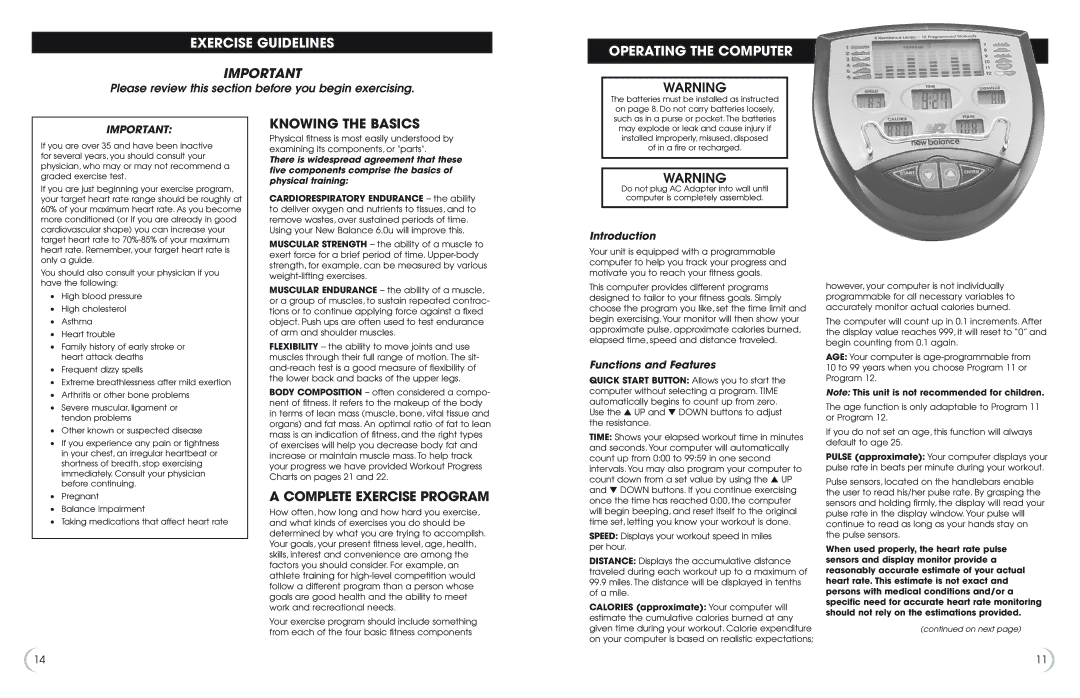
EXERCISE GUIDELINES
IMPORTANT
Please review this section before you begin exercising.
OPERATING THE COMPUTER
WARNING
IMPORTANT:
If you are over 35 and have been inactive for several years, you should consult your physician, who may or may not recommend a graded exercise test.
If you are just beginning your exercise program, your target heart rate range should be roughly at 60% of your maximum heart rate. As you become more conditioned (or if you are already in good cardiovascular shape) you can increase your target heart rate to
You should also consult your physician if you have the following:
•High blood pressure
•High cholesterol
•Asthma
•Heart trouble
•Family history of early stroke or heart attack deaths
•Frequent dizzy spells
•Extreme breathlessness after mild exertion
•Arthritis or other bone problems
•Severe muscular, ligament or tendon problems
•Other known or suspected disease
•If you experience any pain or tightness in your chest, an irregular heartbeat or shortness of breath, stop exercising immediately. Consult your physician before continuing.
•Pregnant
•Balance Impairment
•Taking medications that affect heart rate
KNOWING THE BASICS
Physical fitness is most easily understood by examining its components, or "parts".
There is widespread agreement that these five components comprise the basics of physical training:
CARDIORESPIRATORY ENDURANCE – the ability to deliver oxygen and nutrients to tissues, and to remove wastes, over sustained periods of time.
Using your New Balance 6.0u will improve this.
MUSCULAR STRENGTH – the ability of a muscle to exert force for a brief period of time.
MUSCULAR ENDURANCE – the ability of a muscle, or a group of muscles, to sustain repeated contrac- tions or to continue applying force against a fixed object. Push ups are often used to test endurance of arm and shoulder muscles.
FLEXIBILITY – the ability to move joints and use muscles through their full range of motion. The sit-
BODY COMPOSITION – often considered a compo- nent of fitness. It refers to the makeup of the body in terms of lean mass (muscle, bone, vital tissue and organs) and fat mass. An optimal ratio of fat to lean mass is an indication of fitness, and the right types of exercises will help you decrease body fat and increase or maintain muscle mass. To help track your progress we have provided Workout Progress Charts on pages 21 and 22.
A COMPLETE EXERCISE PROGRAM
How often, how long and how hard you exercise, and what kinds of exercises you do should be determined by what you are trying to accomplish. Your goals, your present fitness level, age, health, skills, interest and convenience are among the factors you should consider. For example, an athlete training for
Your exercise program should include something from each of the four basic fitness components
The batteries must be installed as instructed on page 8. Do not carry batteries loosely, such as in a purse or pocket. The batteries may explode or leak and cause injury if installed improperly, misused, disposed
of in a fire or recharged.
WARNING
Do not plug AC Adapter into wall until computer is completely assembled.
Introduction
Your unit is equipped with a programmable computer to help you track your progress and motivate you to reach your fitness goals.
This computer provides different programs designed to tailor to your fitness goals. Simply choose the program you like, set the time limit and begin exercising. Your monitor will then show your approximate pulse, approximate calories burned, elapsed time, speed and distance traveled.
Functions and Features
QUICK START BUTTON: Allows you to start the computer without selecting a program. TIME automatically begins to count up from zero. Use the ▲ UP and ▼ DOWN buttons to adjust the resistance.
TIME: Shows your elapsed workout time in minutes and seconds. Your computer will automatically count up from 0:00 to 99:59 in one second intervals. You may also program your computer to count down from a set value by using the ▲ UP and ▼ DOWN buttons. If you continue exercising once the time has reached 0:00, the computer will begin beeping, and reset itself to the original time set, letting you know your workout is done.
SPEED: Displays your workout speed in miles per hour.
DISTANCE: Displays the accumulative distance traveled during each workout up to a maximum of
99.9miles. The distance will be displayed in tenths of a mile.
CALORIES (approximate): Your computer will estimate the cumulative calories burned at any given time during your workout. Calorie expenditure on your computer is based on realistic expectations;
however, your computer is not individually programmable for all necessary variables to accurately monitor actual calories burned.
The computer will count up in 0.1 increments. After the display value reaches 999, it will reset to “0” and begin counting from 0.1 again.
AGE: Your computer is
Note: This unit is not recommended for children.
The age function is only adaptable to Program 11 or Program 12.
If you do not set an age, this function will always default to age 25.
PULSE (approximate): Your computer displays your pulse rate in beats per minute during your workout.
Pulse sensors, located on the handlebars enable the user to read his/her pulse rate. By grasping the sensors and holding firmly, the display will read your pulse rate in the display window. Your pulse will continue to read as long as your hands stay on the pulse sensors.
When used properly, the heart rate pulse sensors and display monitor provide a reasonably accurate estimate of your actual heart rate. This estimate is not exact and persons with medical conditions and/or a specific need for accurate heart rate monitoring should not rely on the estimations provided.
(continued on next page)
14 | 11 |
